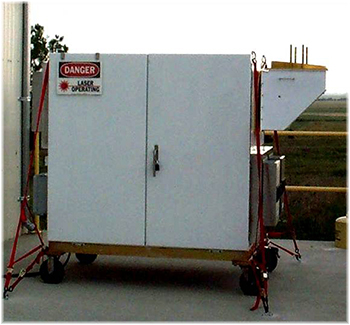Atmospheric Remote Sensing: Instruments
Compact Water Vapor Differential Absorption Lidar (CODI)

Decommissioned
CODI (for COmpact DIAL) is a prototype automated ground-based DIAL – introduction to Differential Absorption Lidar (DIAL) techniques. It continuously measures water vapor profiles to several kilometers above ground.
CSD built this lidar in collaboration with NASA Goddard Space Flight Center and NCAR. The lidar has a weatherproof, temperature-controlled housing. A turning mirror permits the laser beam to be transmitted at any angle from the horizontal to the vertical. The lidar has an eye-safe laser transmitter, a receiver, and computerized electronics for data-taking, monitoring, and synchronization. The transmitter is based on an infrared pulsed diode (flared) amplifier seeded by a cw tunable single-frequency diode laser. Key elements of the receiver include a narrow-band filter to block sky background light and a highly sensitive photon-counting detector.

Basic Parameters Measured
- Water vapor concentration
- Aerosol backscatter
The application of diode laser technology to DIAL systems offers deployable, unattended instruments for continuous water vapor profiling in the lower troposphere. The lidar water vapor measurements at low altitudes can be combined with observations of column-integrated water vapor obtained from ground-based radiometer or Global Positioning System methods to improve the vertical resolution and accuracy of water profiling estimates.
Nighttime DIAL measurements were successfully compared with data from radiosondes and ground-based in situ sensors to evaluate the performance of CODI including its stability, accuracy and resolution. These measurements show that the DIAL works well in an unattended mode. In general, the nighttime water vapor measurements have at least 15% precision and are processed with 30-minute averaging times, 180-m range gates, and a range of about two kilometers. Longer ranges can be obtained by increasing the averaging. The lidar single-channel backscatter profiles also provide cloud base heights and qualitative measurements of aerosols.
The measurements demonstrated the need for several system improvements. High priority improvements will be to obtain a more powerful laser to enhance the lidar's resolution, "near field" optics to measure the water vapor profile below 800 m, and better climate control for the lidar housing. Together, these upgrades will make the lidar a prototype instrument capable of 24-h ground-based measurements in a variety of conditions.
Typical Specifications
| wavelength | 823 nm |
| seed power | 16 mW |
| amplifier peak power | 0.5 W |
| output pulse energy | ~0.15 μJ |
| pulse duration | 600 ns (adjustable) |
| pulse repetition frequency | 8 kHz (adjustable) |
| telescope diameter | 34 cm |
| field-of-view | 180 μrad |
The laser characteristics required for acceptable DIAL performance from a low-power system include stable single frequency light with a TEM∞ mode, pulse durations of less than 1 µs, no pre-pulse light and a pulse repetition frequency near 10 kHz. An all solid-state laser system can have the advantages of simplicity, compactness, stability and energy-efficiency. A broadly tunable laser permits access to the optimum water vapor lines in a wavelength region and also can be switched to different lines as the water vapor density changes. A diode-based laser system is preferred because diode lasers are quite small, simple, rugged, very energy-efficient (~40% QE), and inexpensive to produce in large quantities. Advanced fabrication techniques have resulted in tunable, single frequency diodes for applications requiring high spectral quality. Eye safety can be achieved by working in the infrared and by expanding the transmitted laser beam.

References
Janet L. Machol, Tom Ayers, Karl T. Schwenz, Keith W. Koenig, R. Michael Hardesty, Christoph J. Senff, Michael A. Krainak, James B. Abshire, Hector E. Bravo, and Scott P. Sandberg, Preliminary Measurements with an Automated Compact Differential Absorption Lidar for Profiling Water Vapor, Applied Optics 43, 3110, 2004.
J. L. Machol, Comparison of PN-code and pulsed direct-detection lidars for atmospheric probing, Applied Optics 36, 6021, 1997.